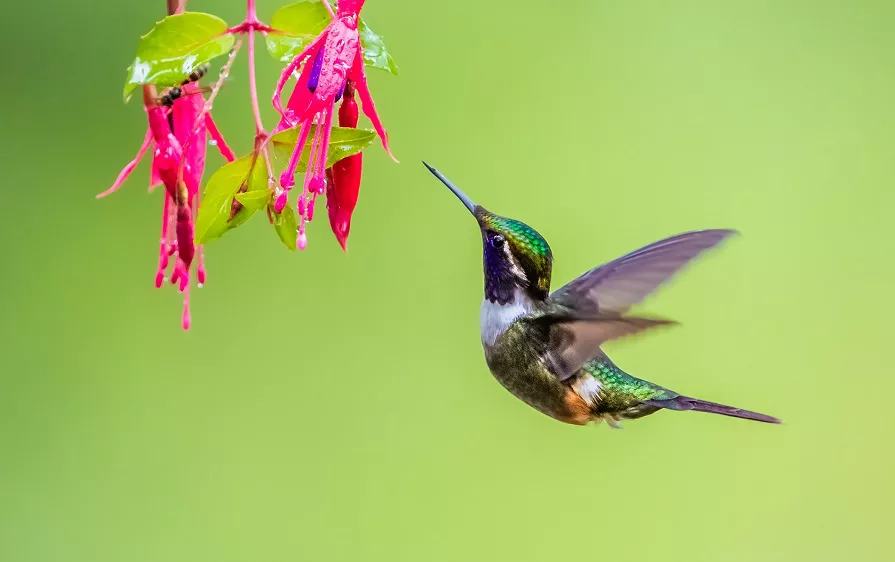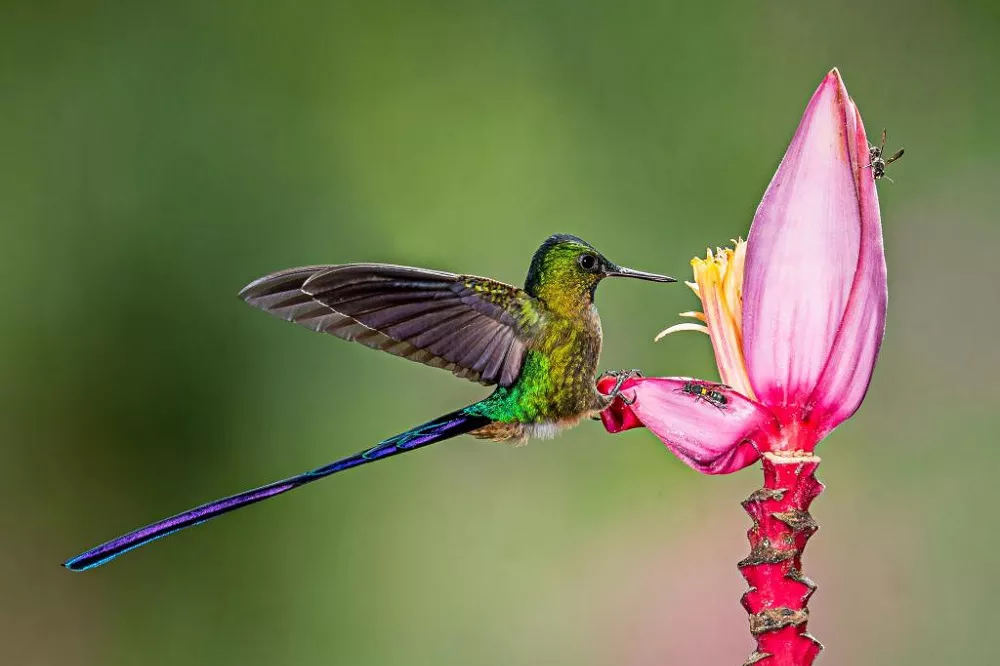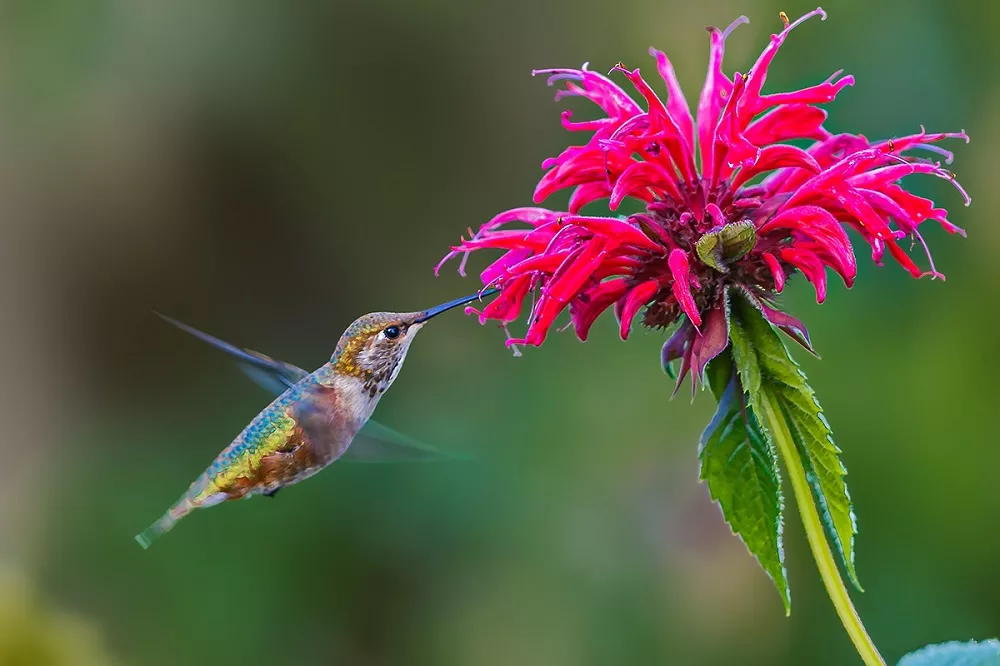Hummingbirds, the tiny, jewel-like birds of the Americas, have fascinated humans for centuries. They are not only admired for their vibrant plumage and extraordinary flight capabilities but also imbued with rich symbolic meanings in various cultures. This article delves into the biological marvels of hummingbirds, their roles in ecosystems, and the diverse symbolic interpretations they hold.
The Biological Marvels of Hummingbirds
Small but Mighty
Hummingbirds are among the smallest birds in the world. The bee hummingbird, native to Cuba, holds the record as the smallest bird, measuring about 2.2 inches long and weighing around 1.8 grams. Despite their diminutive size, hummingbirds are mighty fliers, capable of incredible feats.
Flight Capabilities
Hummingbirds are the only birds that can hover in mid-air, fly backward, and even upside down. Their wings beat at astonishing speeds, up to 80 times per second in some species. This rapid wing movement creates a humming sound, giving the birds their name. The unique ball-and-socket joint at their shoulders allows a 180-degree range of motion in all directions.
Metabolic Wonders
These birds have the highest metabolism of any homeothermic animal. Their heart rate can reach up to 1,260 beats per minute, and they consume about half their body weight in nectar daily to fuel their energy-intensive lifestyle. To conserve energy, hummingbirds can enter a state of torpor, significantly slowing their metabolic rate.
Ecological Roles of Hummingbirds
Pollination
Hummingbirds play a crucial role in pollination. As they feed on nectar, they inadvertently transfer pollen from one flower to another, facilitating plant reproduction. This mutualistic relationship benefits both the birds, who get food, and the plants, which can propagate.
Indicators of Ecosystem Health
The presence of hummingbirds can indicate the health of an ecosystem. They are sensitive to changes in their environment, such as habitat destruction or climate change. A decline in hummingbird populations can signal ecological issues that may need addressing.

hummingbird
Symbolism of Hummingbirds in Different Cultures
Native American Beliefs
In many Native American cultures, hummingbirds are seen as healers and bringers of love, happiness, and good luck. The Hopi and Zuni tribes, for instance, associate hummingbirds with rain and fertility. They believe these birds intercede on behalf of humans with the rain gods, ensuring crops receive enough water.
Mesoamerican Mythology
The Aztecs revered the hummingbird as a symbol of vigor and energy. Huitzilopochtli, the Aztec god of war and the sun, is often depicted as a hummingbird or with hummingbird attributes. The bird’s tireless energy and ability to fly long distances made it an apt symbol for the relentless pursuit of victory and the endurance of the human spirit.
South American Lore
In Peru, the Nazca Lines, ancient geoglyphs in the shape of a hummingbird, demonstrate the bird’s importance in pre-Columbian cultures. These massive drawings, only visible from the air, suggest that the hummingbird was a revered figure, possibly connected to the worship of deities or the natural world.
Modern Symbolism
Today, hummingbirds often represent joy, beauty, and resilience. Their ability to hover and dart gracefully from flower to flower is seen as a metaphor for enjoying the present moment and savoring the sweet things in life. Hummingbirds’ resilience in harsh conditions also symbolizes perseverance and the ability to adapt to life’s challenges.
Hummingbirds in Art and Literature
Artistic Inspiration
Hummingbirds have inspired countless artists across different cultures. Their vibrant colors and delicate forms make them popular subjects in paintings, sculptures, and jewelry. In modern art, hummingbirds are often depicted in dynamic poses, capturing their movement and vitality.
Literary Symbolism
In literature, hummingbirds often symbolize fleeting moments of beauty and joy. They appear in poems and stories as metaphors for love, freedom, and the ephemeral nature of life. Their brief visits to flowers can represent brief, but impactful, moments of happiness or inspiration.
What Does a Hummingbird Symbolize in the Bible?
In the Bible, the hummingbird is a symbol of eternity because of the unique pattern of flapping its wings. Hummingbirds are flapping their wings in a figure-eight shape constantly to keep them afloat, which is why they are thought to represent infinity and continuity.
Hummingbirds are also seen as a sign of faith and hope in the bible, reminding the viewer to stay in the present and not to worry about what is to come or what has already passed.
What Does Seeing a Hummingbird in Your Dreams Mean?
Dreams can be highly personal and subjective, so the meaning of seeing a hummingbird in your dreams can vary depending on the individual’s experiences and associations with hummingbirds.
In general, though, hummingbirds are often associated with beauty, grace, energy, and resilience. They are also known for their ability to hover or move quickly from one place to another, which could symbolize agility or adaptability.
If you see a hummingbird in your dreams, it could represent your desire for freedom, mobility, or the ability to move on from difficult situations. Alternatively, it might indicate that you need to focus on enjoying the present moment, rather than worrying about the past or future.
Of course, these are just broad interpretations, and the true meaning of your dream can only be determined by examining your own thoughts, feelings, and associations with hummingbirds.
What Does it Mean to See a Hummingbird?
In many cultures, hummingbirds are viewed as symbols of joy, love, and happiness. Seeing a hummingbird may be considered a sign of good luck or a reminder to enjoy the little things in life. Some people also believe that hummingbirds carry messages from loved ones who have passed away. In general, encountering a hummingbird can be seen as a positive and uplifting experience.
How to Attract Hummingbirds to Your Garden
Choose the Right Plants
Plant native species that produce tubular flowers, which are ideal for hummingbirds. Examples include trumpet vine, bee balm, and salvia. These plants provide the nectar hummingbirds need and are adapted to the local climate and soil conditions.
Provide Clean Feeders
If you use hummingbird feeders, clean them regularly to prevent the growth of mold and bacteria. Use a solution of four parts water to one part white sugar, and never use honey or artificial sweeteners, as these can harm the birds.
Create a Safe Environment
Avoid using pesticides, as these can poison hummingbirds and their food sources. Provide shelter with trees and shrubs where birds can rest and nest. Ensure there are no outdoor cats, as they can be a significant threat to hummingbirds.
Conclusion
Hummingbirds are more than just beautiful, agile birds; they are ecological keystones and cultural icons. Their presence in our gardens and stories reminds us of the intricate connections within nature and the importance of preserving these delicate ecosystems. By understanding what hummingbirds represent and taking steps to protect them, we can ensure that these extraordinary creatures continue to inspire and thrive for generations to come.
Related topics:
- 7 Fun Facts About Hummingbirds: You Must Be Interested
- Where Do Hummingbirds Sleep? [Revealed!]
- What are Hummingbirds predators?
- How long do Hummingbirds live?



 Facebook
Facebook  Instagram
Instagram  Youtube
Youtube 